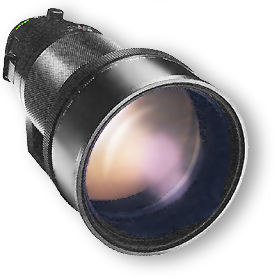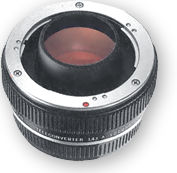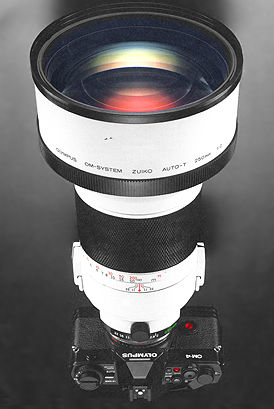 |
Zuiko 350mm F2.8 EDIF |
|
|
I don't remember when exactly both the Zuiko biggies turned to imitate the famed Canon's "L"'s white exterior but I do remember both lenses bear a black chrome finishes when it was announced. These images are scanned from a common 1985 Olympus OM4's catalogue.
Some early official literature stating Olympus' fast Zuiko optics use Extra-low dispersion glass but later ones only indicating the use of "special low dispersion glass with high reflective index.." and never mentioned the exact optical composition it uses in these high speed lenses. The lens when used with its dedicated 1.4X teleconvertor will convert into a great 492mm f/4.0 super telephoto lens.
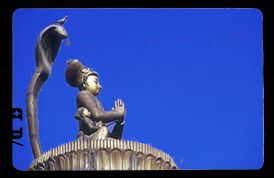 |
Both the Zuiko 250mm f/2.0 and 350mm f/2.8 weighs identically at 3.9kg (137.6oz) and ranked second in terms of weight among all Zuiko lenses behind the 4,150g (146.4oz) Zuiko 1000mm f11 super telephoto lens. The lens is slightly longer at 280mm compared to 248mm of the 250mm f/2.0 and it stops down to f/32 which is useful for extended depth of field use as compared with the f/22 of the 250mm Zuiko counterpart. |
<<<<<<,,,,.Pigeon, Cobra and Statue. An image captured at a recent trip to Pakistan. Generally, blue and red with any ED glass lenses will rendered more faithfully in its color reproduction. Copyright © 2000 Photo courtesy of Mr. MCLau ∝
A new lens used to retail at around USD5,000-00 and it is definitely not an affordable lens for general recreational photographers. Just to satisfy my curiosity, I made a enquiry to the local distributor and was told it is now a special order item within the Zuiko product line which is not surprising. However, kindly aware that Olympus warns this lens is not designed to use in Programmed AE mode with OM2SP, OM40 or other equivalent bodies.
| Specifications Len type: Zuiko 350mm f/2.8 EDIF Focal length: 350mm Lens construction: 7 groups, 9 elements Angles of view: Diagonal: 7‘ * More info on "Picture Angle". Distance scale: (m) 3m (9.8ft) to infinity (OO) Focusing: Internal Focus mechanism Minimum and Maximum aperture: f/32-f/2.8 Diaphragm: Automatic Filter size: Slip-in type Rear filter Length: 280mm Weight: 3,900g (137.6 oz) Recommended Focusing Screens: 1:1*, 1:2*, 1:3*, 1:4n*, 1:6#, 1:7#, 1:10*, 1:13*, 1:14* * Compatible. Focusing and exposure accuracy remains # Can be used, they provide accurate focusing but exposure error may occur in manual mode for OM1 and OM2 series models. Warning: Programmed AE mode in OM2SP, OM40 or others may NOT be usable with this lens. |
|
|
The 1.4X teleconvertor will cause the effective working aperture to lost 1-f/stop of light. Its optical compsotion is comprised of 5 elements arranged in 4 groups, weighing a light 180g (6.3oz) and has a length of only 23mm (0.9in). |
For the few super high speed lenses, Olympus designed a dedicated 1.4X teleconvertor where it magnifies the Zuiko 180mm f/2.0 into a 252mm f2.8 lens, a 250mm f2.0 EDIF into a 350mm f2.8 lens while a 350mm f/2.8 will transformed into a great 490mm f/4.0. Warning: Olympus advises the use of the 1.4XA with only the Zuiko 180mm f/2.0, 180mm f/2.8, 250mm f/2.0, 350mm f/2.8, 300mm f/4.5 and 400mm f/6.3 lenses. The teleconvertor 2X A is usable with Zuiko 100mm f/2.8, 200mm f/4.0, 100-200mm and 50-250mm f/5.0 zoom lenses.
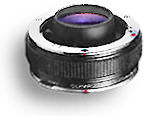 |
Teleconverter 1.4x-A |
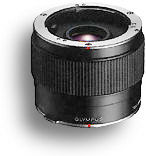 |
Teleconverter 2x-A |
|
Reserved Sample image 1 |
Reserved Sample image 2 |
Reserved Sample image 3 |
Reserved Sample image 4 |
Reserved Sample image 5 |
N O T E: As no photographer in the world would possess ALL the lenses within a single trade name. You are always encouraged to replace these reserved slot for sample images above shooting with a lens type detailed above - just mail in your creative visual, a little caption relative to the background information will help a lot to let other understand how you prepared the shot. Please mention IF you require a complimentary link and where should it be pointed at. Naturally, I DO NOT like to disappoint anyone, but in order to maintain my self-set standard in the PIM website - I would prefer to have high quality input rather than in quantity, if your image is NOT selected for broadcasting in this site, give it a try the next time but I do promise every image will be view and consider carefully. I do appreciate your consideration in this matter.
Things to note when using such long focal length lenses are, as the 400mm lens magnifies the image, it also magnifies camera movement which is probably responsible for ruining many potentially great images. Fortunately, camera shake can be prevented with just a little care like getting proper support or shooting habits and combine it with high speed film types. There's no doubt that with practice most photographers can learn to successfully handhold the 400mm lens.
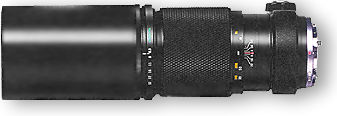 |
Zuiko 400mm F6.3 |
This lens is a popular one with sports, news, nature and travelling photographers who appreciate its unrivaled lightness and compactness. Naturally, as stated on other section in this site, it may not be a good idea to invest into a new lens as its relative slow aperture restrict its flexibility to use it as a day to day lens. Look into a used unit provided the price is reasonable, if you can spare such amount into a new unit, consider other options within similar price category if you can get a better featured lens of other makes. Main problem is, most third party makers do not make lenses with an Olympus mount now so you may still have to fall back to this in the used market.
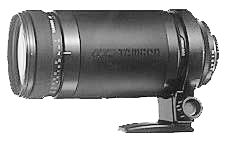 |
Alternatively, think and consider getting a 500mm reflex lens at f/8.0 which is not too far from the f/6.3 of this 400mm lens. |
Yes, I do sound a little negative (Unless as I said earlier, the price is attractive) because I noticed a used camera outlet is selling the Zuiko 400mm f6.3 at USD480-00 ! At that price range, you can possibly get a Tamron Zoom 200-400mm f/5.6 LD (IF) with two moulded Aspherical lens elements while can close focus to a minimum distance of only 2.5m (8.2 ft). Well, at half the cost in the used market, this may prove to be a wise investment, given the fact it is an original Zuiko lens.
| Specifications Len type: Zuiko 400mm f/6.3 Focal length: 400mm Lens construction: 5 groups, 5 elements Angles of view: Diagonal: 6‘ * More info on "Picture Angle". Distance scale: (m) 5m (16.4ft) to infinity (OO) Focusing: Helicoid Minimum and Maximum aperture: f/32-f/6.3 Diaphragm: Automatic Tele-Converter: 1.4X A Filter size: 72mm Length: 256mm Weight: 1,300g (45.9 oz) Recommended Focusing Screens: 1:1**, 1:2*, 1:3**, 1:4n*, 1:6#, 1:7#, 1:8*, 1:10*, 1:13*, 1:14* * Compatible. Focusing and exposure accuracy remains # Can be used, they provide accurate focusing but exposure error may occur in manual mode for OM1 and OM2 series models. ** Not usable with OM2SP and OM40 in Programmed AE mode. |
Specifications Len type: E-Zuiko Auto-T 400mm f/6.3 Focal length: 400mm Lens construction: 5 groups, 5 elements Angles of view: Diagonal: 8‘ Distance scale: (m) 5m (16.4ft) to infinity (OO) Focusing: Helicoid Minimum and Maximum aperture: f/32-f/6.3 Diaphragm: Automatic Filter size: 72mm Length: 255mm Weight: 1,300g (45.9 oz) Recommended Focusing Screens: 1:1**, 1:2*, 1:3**, 1:4n*, 1:6#, 1:7#, 1:8*, 1:10*, 1:13*, 1:14* * Compatible. Focusing and exposure accuracy remains # Can be used, they provide accurate focusing but exposure error may occur in manual mode for OM1 and OM2 series models. ** NOT usable with OM2SP and OM40 in Programmed AE mode. |
| Previous | Back to earlier section featuring the 250mm, 300mm...
